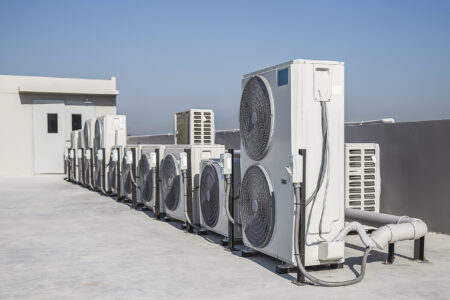
Navigating the complexities of commercial HVAC zoning can feel daunting, especially when balancing the need for energy efficiency with the demand for consistent comfort across diverse spaces. However, with the right plans in place, it is possible to create a business space that not only meets these objectives but also improves the lives of employees, clients, and visitors.
At Controlled Climate Services, we help customers set up and maintain their commercial HVAC systems, including mapping out zoning areas. If you’re ready to take your HVAC zoning to the next level, continue reading as we walk you through actionable steps to optimize your commercial system.
What Is Commercial HVAC Zoning?
Commercial HVAC zoning entails dividing a building into distinct areas, or “zones,” each with its own heating, cooling, and ventilation needs. This method enables precise temperature control across multiple building sections, accommodating varying usage patterns, occupancy levels, and environmental conditions. For example, a conference room that is used a lot might need more cooling than a storage area that is used sparingly.
Zoning allows businesses to tailor their HVAC system to specific needs, increasing overall comfort while reducing energy consumption. Many systems accomplish this through a combination of ductwork dampers, individual thermostats for each zone, and a central control system that oversees the operation. Understanding the fundamentals of HVAC zoning is the first step toward optimizing the climate control in your building, ensuring that each area operates at peak efficiency without overburdening the system or incurring unnecessary energy costs.
Benefits of HVAC Zoning: Why It’s Essential for Your Business
Setting up HVAC zoning in a business building has many advantages that can directly affect the profits for your company and how well it runs. One of the best benefits is that it saves energy. Zoning cuts down on energy use and utility bills by sending heating or cooling only to the areas that need it.
Zoning also makes things more comfortable by letting different rooms stay at various temperatures, which is better for the needs of each room. This is especially helpful in buildings that have multiple types of users, like offices, stores, or facilities that are used for more than one thing.
HVAC zoning can also make your system last longer by reducing the stress on individual units. This means that your system will need fewer repairs and maintenance over time. In the end, fine-tuning the environment in your building makes the people who live or work there more comfortable and happy, but it also helps the business run more efficiently and save money.
Designing an Efficient Zoning Plan: Key Considerations for Your Space
An effective HVAC zoning plan requires careful consideration of the layout of your building, your usage patterns, and your facility’s specific heating and cooling requirements. The first step is to look at different areas in the building and figure out which ones need similar temperatures. For instance, lobbies, conference rooms, and offices might all need their own zone, while bathrooms and storage areas can often be combined.
It’s also wise to consider how often each zone will be used. Zones that are packed at various points during the day but relatively empty at others will need more flexible temperature control. Once you’ve decided on which zones you will create, the next step is to figure out where to place the thermostats and the dampers to ensure precise control. It’s critical to have HVAC professionals involved in this process to make sure the system is set up to work as efficiently and effectively as possible.
Integrating Smart Technology: Enhancing Control and Performance
Smart thermostats and zoning systems let you make precise real-time changes based on occupancy, preference, and many other factors. These systems can be set to change the temperature on their own during off-peak times or when certain parts of the building are empty, which saves even more energy.
Smart technology lets you monitor and control things from afar, meaning that facility managers can make changes from anywhere using their computers or smartphones. This level of control not only makes the HVAC system work better but also lets you fix problems quickly if they happen.
Regular Maintenance: Keeping Your Zoned HAC System Running Smoothly
HVAC zoning needs to be serviced and checked regularly to keep everything running at its best and avoid problems. This includes checking and cleaning the dampers, making sure the thermostats work right, and checking the airflow through the system to make sure each zone is getting the right amount of heat or cool air. As part of regular maintenance, the central control system must also be checked for any signs of wear or malfunction. Ask us about our HVAC maintenance plans!
Contact Us Today
Mastering commercial HVAC zoning is important for creating a comfortable, energy-efficient environment that meets the needs of your company. These tips can ensure that your system works at its best, saving you money and making you more comfortable.
Contact Controlled Climate Services today and take control of your HVAC zoning. We know you’ll love the difference it makes in your commercial space.
